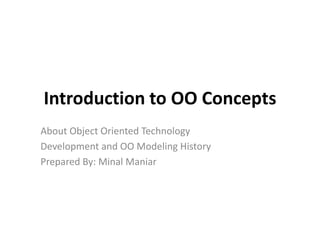
modeling concepts
- 1. Introduction to OO Concepts About Object Oriented Technology Development and OO Modeling History Prepared By: Minal Maniar
- 2. Outline • Object Oriented Technology – What is Object-Orientation? – OO Themes • Development and OO Modeling History – What is OO Development? – OO Modeling History – Modeling Concepts – Modeling as a Design Technique – Modeling – Abstraction – The 3 Models (Class Model, State Model, Interaction Model)
- 3. Object Oriented Technology • What Is Object-Orientation? • Characteristics of Object – Identity – Classification – Inheritance – Polymorphism
- 4. OO Development • What Is OO Development? – It is a conceptual process independent of a programming language until the final stages- way of thinking , not a programming technique • Software life Cycle – System Conception – Analysis – System Design – Class Design – Implementation
- 5. OO Development(2) • Modeling Concepts, Not Implementations – In Past , OO community focused on Programming languages, emphasizing on implementation rather than underlying thought process – Difficulties in addressing front-end conceptual issues • OO Methodology – System Conception – Analysis – System Design – Class Design – Implementation
- 6. OO Modeling History • OMT – introduced in 1991 • Popularity of OO modeling led to a new Problem – Plethora of alternative notations, - similar idea - Different Symbols • Consolidating the Various notations
- 7. OO Modeling History(2) 1994 Rumbaugh and Grady Booch started working on unifying the OMT notations 1995 Ivar Jacobson joined this work 1996 OMG issued a request for standard OO modeling notations 1994 OMG accepted the resulting UML as a standard The participating companied transferred UML rights to the OMG 1996 OMG issued a request to various organizationsfor standard OO modeling notations 2001 OMG members revised specifications – UML 1
- 8. Useful Links • Useful Links: – http://www.omg.org/spec/UML/2.4.1/ – http://www.omg.org/gettingstarted/gettingstarte dindex.htm – http://www.uml.org/
- 9. UML • The Unified Modeling Language™ (UML®) is a standard visual modeling language intended to be used for modeling business and similar processes, analysis, design, and implementation of software-based systems • UML is a common language for business analysts, software architects and developers used to describe, specify, design, and document existing or new business processes, structure and behavior of artifacts of software systems. • UML can be applied to diverse application domains (e.g., banking, finance, internet, aerospace, healthcare, etc.) It can be used with all major object and component software development methods and for various implementation platforms (e.g., J2EE, .NET).
- 10. Modeling Concepts Modeling as a Design Technique Class Modeling State Modeling Interaction Modeling
- 11. Modeling as a Design Technique • What is model?– A model is a simplification of reality. It is an abstraction of something for the purpose of understanding it before building it. – Examples: architectural models, airplane model for wind tunnel test, pencil sketches for oil paintings, blueprint of machine parts, outline of books
- 12. Why we Model? • Purpose of Modeling: – Testing a physical entity before building it – Communication with Customers – Visualization – Reduction of Complexity • Thus, through modeling we achieve four aims. – Models help us to visualize a system as it is or as we want it to be. – Models permit us to specify the structure or behavior of the system. – Models give us a template that guides us in constructing a system. – Models document the decision we have made.
- 13. Modeling as a Design Technique(2) • The Three Models – Class Model: describes the structure of objects in a System their identity, relationships to other objects, their attributes and their operations – It provides the context for the state and interaction models – State Model – Interaction Model • Relationship among the Models
- 14. UML Modeling Types • Structural Modeling: captures the static features of a system • Behavioral Modeling: describes the interaction in the system. It represents the interaction among the structural diagrams
- 16. References • Book Object-Oriented Modeling and Design with UML by Michael Blaha James R Rumbaugh • www.youtube.com/watch?v=3cmzqZzwNDM • creately.com/blog/diagrams/uml-diagram-types- examples/
